| Day 1 Xian ( ) |
| Our tour guide will hold a welcome sign to meet you at Xian Airport according to your flight schedule, then transfer to the hotel, relax for the rest of the day. Recommend you to enjoy the famous Tang Dynasty Show for night entertainment (optional). |
Xian | Xi’an, named “Chang’an” in ancient time, is the ancient capitals of 13 dynasties, dating back to 3100 years ago. It’s the starting point of the Silk Road and honored as the World Historic City by UNESCO in 1981. Hence, it’s the first choice for those Chinese civilization lovers. |
|
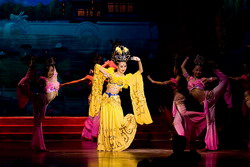 |
| [ Optional ] Tang Dynasty Dinner Show: The Tang Dynasty show has absorbed all the best music from the past dynasties and that of western regions and other countries. It vividly reflects their thriving economy, the friendly relationship between Tang and its neighboring countries, and the daily life of the Tang people. |
|
| Day 2 Xian ( B,L ) |
| The highlight today is the visit of Terra Cotta Army Museum. |
Xian Bell Tower | Built in 1384 A.D, the Bell Tower boasts a history of over 600 years. It is the largest and best-preserved of its kind in China. Visiting the Bell Tower, you can still see the Big Iron Bell which was made in Ming Dynasty, 2,500 kilograms in weight. | Big Wild Goose Pagoda | It was built in 652 during the Tang Dynasty and currently boasts height of seven stories. It’s said that Master Xuan Zang built this pagoda to house the Buddhist scriptures and relics he had brought back from India. | Terra Cotta Warriors and Horses Museum | Terracotta Warriors is the underworld terracotta army of Emperor Qin Shihuang (the first unifier of China, 259BC-210BC). It’s reputed as the Eighth Miracle of the World. Now the Terracotta Museum consists of Pit 1, Pit 2, Pit 3 and Pit 4 as well as the Hall of the two bronze chariots and horses. |
|
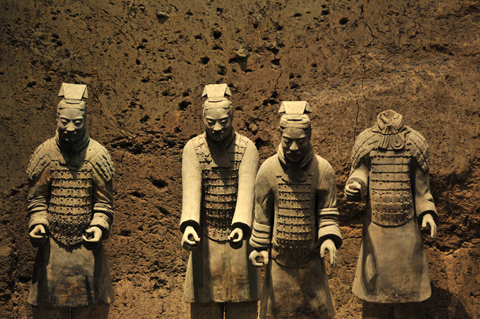 |
| [ Optional ] Muslim quarter: The Muslim Quarter features a mix of Chinese and Islamic cultures. It wins the reputation for the alley lined with market stall and the tasty snack food. Meanwhile, it is a good place to head for when looking for those hard-to-find souvenirs. |
|
| Day 3 Xian, Lanzhou ( B,L ) |
| Continue your city tour in Xian. Later today you will be transferred to Xian airport for your flight to Lanzhou. Upon arrival at Lanzhou airport, pickup by our English speaking tour guide and drive to hotel. Relax for the rest of the day. |
Hanyangling Museum | It is quite near the Xian airport, about 20 km north from downtown Xian, a tomb of the fourth Emperor Jing (Liu Qi) and his queen in Western Han Dynasty (206 BC-24 AD). There is a research center here and you can still see people working on terra cotta warriors protection. Collection of the most im…… | Ancient City Wall | It is the most well-preserved ancient military defensive systems in the world. It is composed of the moat, hanging bridges, battlements, watchtowers, tunnels and parapet. Today, the roadway is a promenade enjoyed by strolling tourist. Cycling on the wall with families is a great thing! |
|
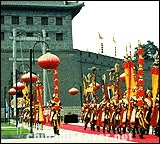 |
| [ Optional ] Gansu Provincial Museum: The Gansu Provincial Museum (Gansusheng bowuguan), covering a total area of 16.5 acres, is the most impressive museum in the province. This is one of the best sights in the city, and for those who are in the western section of Lanzhou, a visit is well worthwhile. |
|
| Day 4 Lanzhou ( B,L ) |
| Morning city tour in Lanzhou, free time in the afternoon. Seeing off at Lanzhou Railway Station to take an overnight train (soft sleeper class, 4 berths in one compartment) to Jiayuguan. Stay overnight on the train. Train No.: T927 (22h20-07h23) (leave Lanzhou at 22h20, arrive Jaiyuguan at 07h23 next day). |
Train T927 Lanzhou to Jiayuguan | T927 train is running on routes Lanzhou to Yumen, stops at Jiayuguan. Train No.: T927 (leave Lanzhou at 22h20, arrive Jaiyuguan at 07h23 next day). The time for boarding at Datong and arriving at Pingyao is perfect for an overnight stay. These trains have soft class with 4-berth ordinary soft class …… | White Pagoda Hill Park | The White Pagoda Hill Park: Located to the north of the city, on the far bank of the Yellow River, the White Pagoda Hill Park is a large, quiet area. From the hill one can have a bird's eye view of the Yellow River. | Five Springs Mountain Park | The Five Springs Mountain Park (Wuquan shan gonyuan) is, along with it's neighbor Lanshan Park, a pretty area of mountain scenery, artificial temples and winding paths. These two spots will take up a good day and are a worthy rest away from the bustle of the strip of city that can be seen from below…… |
|
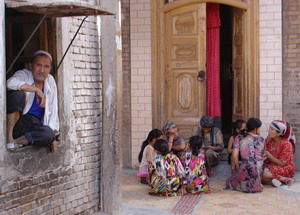 |
| [ Optional ] Lanzhou: Lanzhou is situated on the upper course of the Yellow River, where the river emerges from the mountains. It has been a center since early times, being at the southern end of the route leading via the Hexi Corridor across Central Asia. It is the capital and largest city of Gansu Province in Northwestern China, a key regional transportation hub, allowing areas further west to maintain railroad connections to the eastern half of the country. |
|
| Day 5 Jiayuguan, Dunhuang ( B,L ) |
| Upon arrival at Jiayuguan railway station, pickup by our English speaking tour guide and start our visiting around Jiayuguan. Later today we'll drive 2 hours to Yumen. Stay overnight in Yumen. |
Tombs of Jin and Wei Dynasties | About 20km away from the Jiayu Pass, the ancient tombs of the Wei and the Jin Dynasties are situated on the Gobi in Xincheng Town, Gansu Province. They are famous tomb groups of underground mural painting bricks in China and they deserve the title of "the largest underground gallery in the world". | Overhanging Great Wall | The impressive Overhanging Great Wall (Xuanbi changcheng), linking Jiayuguan with the Black Mountain (Hei shan), lies 8km northwest from the Jiayuguan Fort. | Jiayuguan Pass | Jiayuguan Pass is the first pass at the west end of the Great Wall of China and was built during the Ming Dynasty. Located 6 kilometers southwest of Jiayuguan City which is in Gansu Province, It is the western terminal of the world famous Great Wall as well as the third biggest gliding bade in the w…… |
|
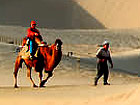 |
| [ Optional ] Gobi Desert: The Gobi desert is a large desert region covering parts of northwestern China and of southern Mongolia. The desert basins of the Gobi are bounded by the Altai Mountains and the grasslands and steppes of Mongolia on the north, by the Hexi Corridor and Tibetan Plateau to the southwest, and by the North China Plain to the southeast. The Gobi is most notable in history as part of the great Mongol Empire, and as the location of several important cities along the Silk Road. |
|